The Feasts of the LORD
Fulfillment of prophetic meaning in the past, present and future
Hartmut Ising
Introduction
The seven feasts of the LORD are described in detail in Leviticus 23. These feasts have prophetic meanings. There have been many excellent books written on this subject. Therein, however, I have noticed a lack of distinction between prophecy for Israel and prophecy for the church. This is particularly true on the subject of the Feast of Pentecost and the Feast of Trumpets, i.e. the 4th and 5th Feast. Therefore, my focus is on these two feasts.
By way of introduction, I would like to quote Eugene P. Vedder, Jr., who provides some basic principles for interpreting prophecy:
# No prophecy in Scripture has a private or independent interpretation - everything must be understood as part of a grand plan that is in harmonious relationship to the whole (see 2Pet.1,20-21).
# To properly understand prophecy, it is important to understand the difference between Israel, the nations – also called Gentiles – and the church – also called the assembly. The church is never directly mentioned in the Old Testament.
# God's dealings with humanity are always consistent throughout dispensations – periods in which God tests man in a particular way.
# Symbols used in prophecy are used consistently, not randomly or with contradictory, confusing meanings.
# Clear scriptures must be used when interpreting less clear scriptures.
The first three feasts are fulfilled in Jesus Christ
The first three feasts have already been fulfilled in our Lord Jesus Christ (cf. my article: “Old Rabbinical Interpretations of Messianic Prophecy”). The first feast, Passover, was celebrated on the first day of the first month. The fulfillment was the death of the Lamb of God (1Cor.5,7b). The subsequent Feast of Unleavened Bread lasted a week and is the prophetic foreshadowing of the perfect life of Jesus Christ (1Pet.2.22). The Feast of the Firstfruits was celebrated on the day after the Sabbath of the festival week. In the year 33 AD. this Sabbath fell on the day of Passover. On Sunday, the day after this Great Sabbath (Joh.19,31), the foreshadowing of the firstfruits sheaf was fulfilled in the resurrection of Jesus Christ (cf. my articles: “The Servant Songs in the Book of Isaiah” and “Thoughts on the Expectation of the Messiah”).
The Feast of Pentecost is being fulfilled in the Christian Church
Seven weeks after the Feast of the Firstfruits, the Feast of Pentecost took place. On this day the fulfillment of this feast began with the outpouring of the Holy Spirit on the believers gathered in Jerusalem:
And when the day of Pentecost was fully come, they were all with one accord in one place. And suddenly there came a sound from heaven as of a rushing mighty wind, and it filled all the house where they were sitting. And there appeared unto them separated tongues like as of fire, and it sat upon each of them. And they were all filled with the Holy Spirit, and began to speak with other tongues, as the Spirit gave them utterance (Act.2,1-4).
At this feast, two leavened breads were to be offered as a firstfruits offering:
You shall bring out of your dwellings two wave loaves of two-tenths of an ephah: they shall be of fine flour; they shall be baked with leaven; they are the first fruits unto the LORD (Lev.23,17).
This was the only offering made from leaven. These loaves of bread represent the Jews and the Gentiles who were created into a new man in Christ:
For he is our peace, who has made both one, and has broken down the middle wall of partition between us; Having abolished in his flesh the enmity, even the law of commandments contained in ordinances; to make in himself of two one new man, so making peace; And that he might reconcile both unto God in one body by the cross, having slain the enmity thereby (Eph.2,14-16).
This new man is the Church, the entirety of all God's children from the first Pentecost until the Rapture.
The Rapture ends the prophetic fulfillment of Pentecost
The end of the church era is the rapture, which our Lord Jesus first announced in Joh.14,2-3:
In my Father's house are many mansions: if it were not so, I would have told you. I go to prepare a place for you. And if I go and prepare a place for you, I will come again, and receive you unto myself; that where I am, there you may be also.
In 1Cor.15,51-52 it is announced that the rapture will take place at the sound of the last trumpet. What is the last trumpet? Is it the last of the seven judgment trumpets in Revelation? The Old Testament model for this are the seven trumpets (Jos.6,4), which were blown before the conquest of Jericho. These instruments were ram's horns or shofars, which announced the judgment of Jericho. Since the Rapture takes place before God's great judgment day on this earth (see my article, "The Rapture of the Church before God's Judgment on this Earth"), the 7th trumpet in Revelation cannot be meant.
Some commentators hold that the last trumpet was the third signal for the Roman army. The Greek historian Polybius described the meaning of the three signals: 1st Fold up down tents and pack together; 2nd Load the pack animals; 3rd Departure.
– Is this signal sequence really a model for the Church?
In contrast, in the New Testament there are several examples of sequences of two events, whereby the second is also the last, e.g. in 1Cor.15,45 & 47:
And so it is written, The first man Adam was made a living soul; the last Adam was made a life-giving spirit. The first man is of the earth, made of dust: the second man is the Lord from heaven.
In the Old Testament we find two silver trumpets beside to the seven judgment trumpets:
Make you two trumpets of silver; of a whole piece shall you make them: that you may use them for the calling of the assembly, and for the journeying of the camp. 5 When you blow an alarm, then the camps that lie on the east side shall go forward (Num.10,2 & 5).
The sound that is here translated “blow an alarm” is a “joyful sound”. This becomes clear from the translation of the Hebrew word “terua” used here and in Ps.89,15:
Blessed are the people that know the joyful sound.
During the desert journey, the first trumpet signal was for the calling of the assembly.
Since Pentecost, the gospel call has sounded out to gather the church. The apostle Paul writes in 1Thes.1,8:
From you sounded out the word of the Lord
and uses the Greek verb “execheomai”: to sound out, i.e. the trumpet sound.
The last trumpet, the sound of joy
The “last trumpet” sounds after the completion of the calling or gathering of the church,
when the fullness of the nations has come in (Rm.11,25).
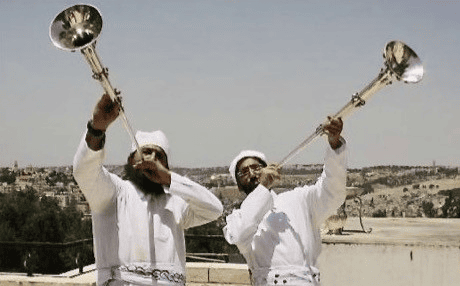
Figure 1: Two silver trumpets
The sound of the silver trumpets is bright and joyful. One of my friends with a good knowledge of the Hebrew language explained to me that the Hebrew word “terua” describes a joyful sound. At the sound of jubilation, the sound of the last trumpet, the rapture of the church takes place. We wait for this event every day. With this sound of jubilation, the time of the church – and in the prophetic example the feast of Pentecost – is completed.
Table 1 provides an overview of the seven feasts of the LORD. The first three feasts were fulfilled in the past. The fulfillment of Pentecost began almost 2,000 years ago and still continues today. The rapture of the church will be the completion of the fulfillment of Pentecost. Now we will consider the three final feasts and their fulfillment in Israel in the future.
The 5th feast, the Feast of Trumpets, Rosh HaShana
After Pentecost there is an interim period of more than four months in the Jewish calendar.
In the seventh month, in the first day of the month, shall you have a sabbath, a memorial of blowing of trumpets, a holy convocation (Lev.23,24).
The blowing of trumpets is in Hebrew “terua”, the joyful sound.
Table 1: Overview of the seven feasts of the LORD
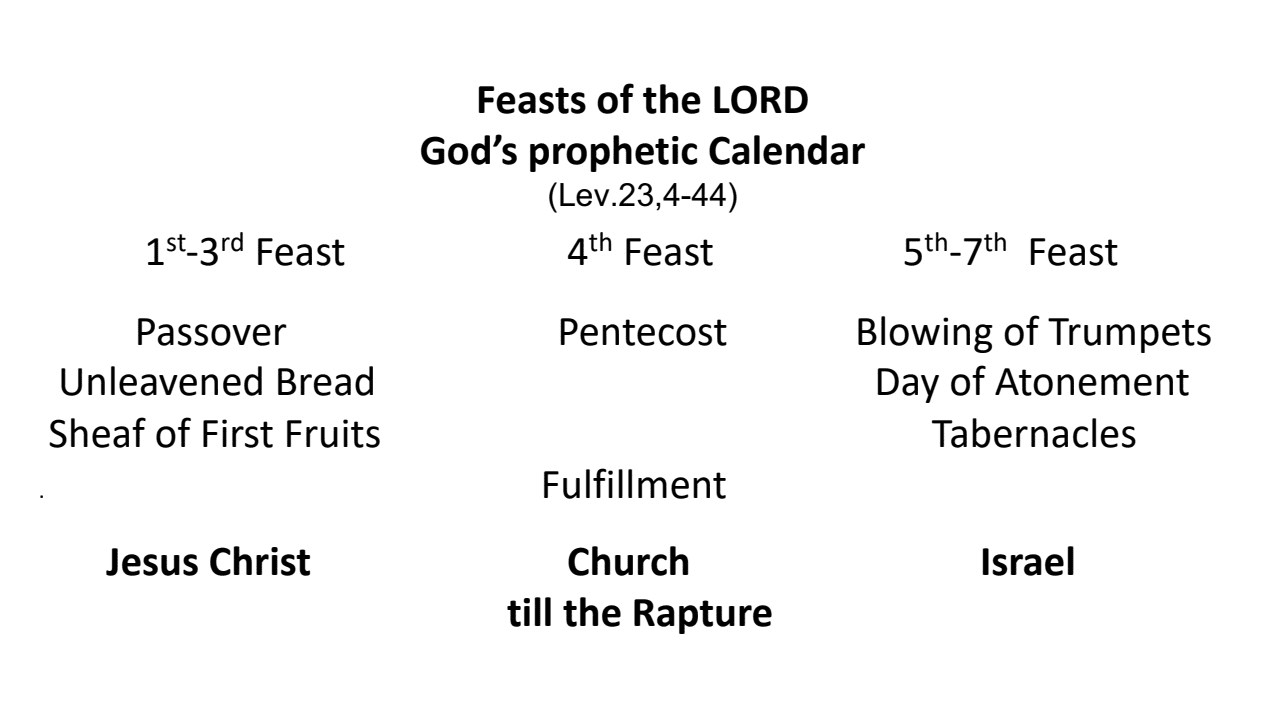
Table 1 provides an overview of the seven feasts of the LORD. The first three feasts were fulfilled in the past. The fulfillment of Pentecost began almost 2,000 years ago and still continues today. The rapture of the church will be the completion of the fulfillment of Pentecost. The three final feasts will all be fulfilled in Israel in the future.
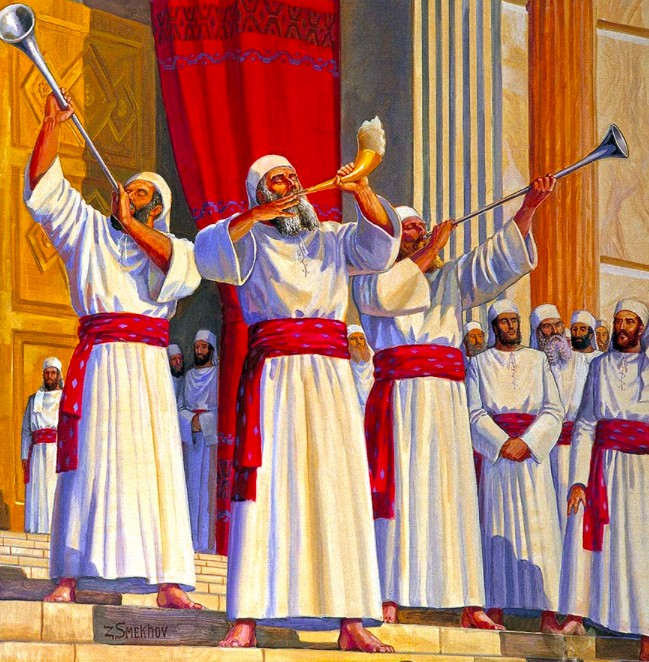
Figure 2: Announcement of the Feast of Trumpets by the sound of silver trumpets and the shofar (https://templeinstitute.org - Rosh HaShana 2).
Originally, this holiday was a celebration of joy that was announced with the sound of jubilation. When the people came together after their return from Babylonian captivity on the 1st of the 7th month and the Book of the Law was read to them, they mourned and wept. But on this day this was inappropriate, so Ezra encouraged the people and said:
This day is holy unto the LORD your God; mourn not, nor weep. For all the people wept, when they heard the words of the law (Neh.8,10).
A few years earlier, the Jews who had returned from Babylon had begun the sacrificial service on the altar of burnt offering in Jerusalem on this feast day:
And when the seventh month was come, and the children of Israel were in the towns, the people gathered themselves together as one man to Jerusalem.
And they set the altar upon its bases; for fear was upon them because of the people of those countries: and they offered burnt offerings thereon unto the LORD, even burnt offerings morning and evening.
From the first day of the seventh month began they to offer burnt offerings unto the LORD. But the foundation of the temple of the LORD was not yet laid (Ez.3,1 & 3 & 6).
After the destruction of Temple in 70 AD. trumpets were omitted when announcing this feast to express mourning over the destruction of the Temple.
In the 1990s, I had the opportunity to speak with a rabbi from the Temple Institute in Jerusalem. I asked him whether the temple in Jerusalem was necessary for the sacrificial service. He reminded me of the Bible passage quoted above and commentated that only the altar of burnt offering is required for the sacrificial service. Therefore, the day is already known on which this service will begin, Rosh HaShana, but the year is unknow.
Access to the original location of the temple and altar is possible from the tunnel on the western wall of Temple Mount (see my essay: “The Future of the Temple in Jerusalem”). The political conditions for the start of the sacrificial service are currently being gradually prepared, as shown below.
The sacrificial offerings begin with the entry into force of a 7-year covenant
Daniel 9,26-27 describes the long period between the destruction of the Temple in the year 70 and the recommencement of the sacrificial service in the future:
And after threescore and two weeks shall Messiah be cut off, but not for himself: and the people of the prince that shall come shall destroy the city and the sanctuary; and its end shall be with a flood, and unto the end of the war desolations are determined. And he (the coming prince) shall confirm the covenant with many for one week: and in the midst of the week he shall cause the sacrifice and the offering to cease, and for the overspreading of abominations he shall make it desolate, even until the consummation, and that determined shall be poured upon the desolate.
The coming prince will make a covenant with the many of Israel for a year-week, that is, for seven years. Since this prince will stop the sacrificial service after 3 ½ years, the sacrificial service must have begun when this covenant comes into force.
In 1993, an attempt was made to secure peace in the
Middle East through a 7-year treaty. This treaty was concluded between Arafat, the leader of the Palestinians and Israel. In addition, the Jerusalem problem was to be resolved in the final year of the contract. Hamas tried to boycott the peace treaty with Israel through suicide attacks. As long as Hamas is in power, the biblical 7-year contract cannot be concluded. However, the treaty announced in Daniel is concluded between the future prince of the Roman Empire in its final phase and Israel, and the Jerusalem problem is solved when this treaty comes into force.
The Oslo peace treaty failed. Advisors to the President of the United States judged at the time that the main problem for Middle East peace was the Temple Mount/Haram al-Sharif. A stable solution to the problem required an amicable division of the Temple Mount/Haram al-Sharif. At that time, it was proposed to divide this area horizontally. The above-ground part with the Dome of the Rock and the Al Aqsa Mosque should go to the Muslims, the underground part to the Jews. This is possible because 2000 years ago the surface was 6 m to 12 m below the current surface.
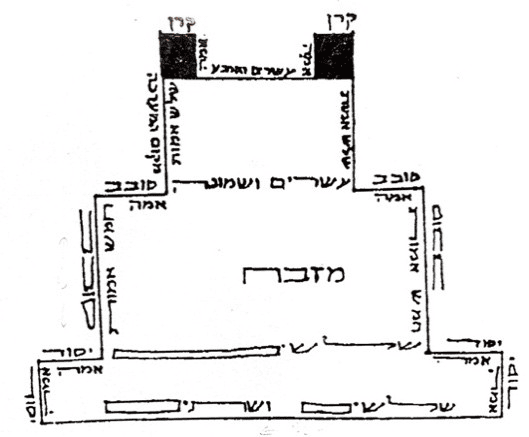
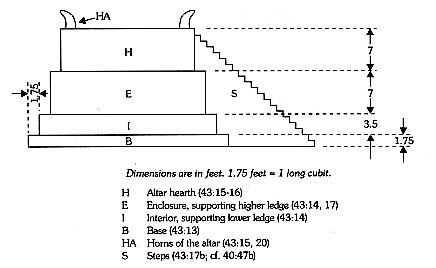
Figure 3: The burnt offering altar at the time of Herod, left: sketch by Maimonides, measurements in Hebrew, right: modern scale sketch with measurements in feet (total height approx. 5.8 m).
At the time of our Lord Jesus the burnt offering altar had already the dimensions of the altar described in Ez.43,13-17 for the messianic kingdom of peace. The temple could not be built in the dimensions described by Ezekiel because the temple site was at that time far too small. Is the size of the altar perhaps an indication that future sacrificial service will begin on it?
Who is the Coming Prince?
Since the Romans destroyed the Temple in Jerusalem, the “Coming Prince” is a ruler of the Roman Empire in its final form. This final form is shown in two pictures in the book of Daniel, first in the image that king Nebuchadnezzar saw in his dream:
You, O king, saw, and behold a great image. This great image, whose brightness was excellent, stood before you; and its form was frightening. This image's head was of fine gold, its breast and its arms of silver, its belly and its thighs of bronze, Its legs of iron, its feet part of iron and part of clay (Dan.2,31-33).
Since the feet end in ten toes the final form of this imperium will consist of ten parts.
In chapter 7, Daniel is shown the four world empires figuratively as different animals. The 4th empire is described as a terrible animal with 10 horns:
After this I saw in the night visions, and behold a fourth beast, dreadful and terrible, and strong exceedingly; and it had great iron teeth: it devoured and broke in pieces, and stamped the residue with its feet: and it was diverse from all the beasts that were before it; and it had ten horns (Dan.7,7).
A special ruler will arise from the 4th empire:
I considered the horns, and, behold, there came up among them another little horn, before whom there were three of the first horns plucked up by the roots: and, behold, in this horn were eyes like the eyes of man, and a mouth speaking great things (Dan.7,8).
This dictator will have absolute power for 3 ½ years:
Thus, he said, the fourth beast shall be the fourth kingdom upon earth, which shall be diverse from all kingdoms, and shall devour the whole earth, and shall tread it down, and break it in pieces. And the ten horns out of this kingdom are ten kings that shall arise: and another shall rise after them; and he shall be diverse from the first, and he shall subdue three kings. And he shall speak great words against the Most High and shall wear out the saints of the Most High, and think to change times and laws: and they shall be given into his hand until a time and times and the dividing of time (Dan.7,23-25).
Before this dictator reveals his satanic wickedness, he will facilitate the sacrificial service on the altar of burnt offering in Jerusalem as part of a 7-year contract. A compromise will be negotiated: Israel will have access to the original location of the Temple and the altar of burnt offering. To do this, Israel must hand over sovereignty over the Old City of Jerusalem to the United Nations. This follows from Rev.11,1-2:
And there was given me a reed like unto a rod: and the angel stood, saying, Rise, and measure the temple of God, and the altar, and them that worship therein. But the court which is outside the temple leave out, and measure it not; for it is given unto the Gentiles: and the holy city shall they tread under foot forty and two months.
This prophecy will be fulfilled at the beginning of Israel's final week of years. During the first half of this 7-years-period, the sacrificial service takes place in Jerusalem. During this period the Holy City, including the outer court of the Temple, is given to the nations – that is, under the rule of the United Nations.
The Gospel of the Kingdom
During this time the gospel of the kingdom is proclaimed (Mt.24,14):
And this gospel of the kingdom shall be preached in all the world for a witness unto all nations; and then shall the end come.
Our Lord Jesus refers to this in Matthew 25 saying:
“Then shall the kingdom of heaven be likened unto ten virgins” at that time.
The five wise virgins have oil and burning lamps, they preach the gospel of the kingdom and are allowed to take part in the wedding of the Lamb. In my opinion they are the 144,000 from the 12 tribes of Israel who are sealed before the beginning of God's judgment on earth and who appear with the Lamb on the heavenly Mount Zion in Rev.14,1 & 4b:
And I looked, and, lo, a Lamb stood on mount Zion, and with him a hundred and forty-four thousand, having his Father's name written in their foreheads.
These were redeemed from among men, being the first fruits unto God and to the Lamb.
The five foolish virgins also go to meet the bridegroom, but they have no burning lamps.
The oil is a picture of the Holy Spirit. They have no oil and no burning lamps i.e. they are not sealed with the Holy Spirit and have no witness for the coming Messiah. Therefore, they are not allowed to attend the wedding (see my article: “God’s Plan for Israel”).
The Coming Prince reveals himself as the man of perdition
In the middle of the last week of years of Israel, the 7th trumpet of God's judgment will sound on this earth and the dictator's unlimited power will begin for 3 ½ years.
Then he reveals himself as
the son of perdition; Who opposes and exalts himself above all that is called God, or that is worshiped; so that he as God sits in the temple of God, showing himself that he is God (2Thes.2,3b-4).
As a first proof of his power he will kill the two witnesses, authorized by God:
And their dead bodies shall lie in the street of the great city, which spiritually is called Sodom and Egypt, where also our Lord was crucified (Rev.11,8).
After 3 ½ days they are resurrected and ascend to heaven in front of their enemies. At this time a woman appears in heaven, of whom it is said in Rev.12,5-6:
And she brought forth a male child, who was to rule all nations with a rod of iron: and her child was caught up unto God, and to his throne.
And the woman fled into the wilderness, where she has a place prepared by God, that they should feed her there a thousand two hundred and three score days.
(See my article: “The Mystery of the Good News in the Darkest Days”)
In these last 3 ½ years the Temple will be desecrated by the coming dictator. The temple must therefore have been built in the first 3 ½ years. This second half of Israel's last seven years is the time of greatest or most intense tribulation:
There shall be a time of trouble, such as never was since there was a nation even to that same time: and at that time your people shall be delivered, every one that shall be found written in the book (Dan.12,1).
At the end of this terrible tribulation, the LORD will save the faithful of his people who did not worship the dictator or his abomination in the temple and destroy the enemies that come against Jerusalem (Zech.12,9). This happens before the Great Day of Atonement, Yom Kippur.
The 6th Feast, the Day of Atonement, Yom Kippur
Israel's acceptance of their Messiah, who died as an atonement 2,000 years ago, is described in Zech.12,10:
I will pour upon the house of David, and upon the inhabitants of Jerusalem, the Spirit of grace and of supplications: and they shall look upon me whom they have pierced, and they shall mourn for him, as one mourns for his only son, and shall be in bitterness for him, as one that is in bitterness for his firstborn.
These Jews, who believed in the Old Testament, did not recognize their suffering Messiah during the entire time. Only now, when they are allowed to see him in his divine power and glory, do they recognize him and weep over his death.
For a long time, some Jews had understood something of what had been prophesied about the Messiah.
In the prayer book for the holidays ("Mahzor Rabbah") there was a prayer by Rabbi Eliaz Ha-Qalirar until around 1930, which contains the following request: „Messiah our Righteousness is departed from us: horror hath seized us, and we have none to justify us. He hath borne the yoke of our iniquities, and our transgression, and was wounded because of our transgression. He beareth our sins on his shoulder, that he may find pardon for our iniquities. We shall be healed by his wound, at the time that the Eternal will create him (the Messiah) as a new creature. O bring him up from the circle of the earth. Raise him up from the land of Seir, to assemble us on Mount Lebanon, a second time by the power of Yinon.”
(Seir is a secret name for Rome and Lebanon indicates the Temple.)
Zechariah writes about the coming of the LORD:
And the LORD my God will come, and all the saints with you (Zech.1,5).
This LORD and God is Jesus Christ, who will not come alone, but with all his saints:
at the coming of our Lord Jesus Christ with all his saints (1Thes.3,13).
The judgment of the living from the nations before the kingdom of peace
Before the beginning of the messianic kingdom of peace, the Messiah will judge the people who have survived God's judgments (Is.63,1-6; Rev.19,16-20):
When the Son of man shall come in his glory, and all the holy angels with him, then shall he sit upon the throne of his glory: And before him shall be gathered all nations: and he shall separate them one from another, as a shepherd divides his sheep from the goats (Mt.25,31-32).
The Son of Man comes to this earth with power and glory (Mt.24,30) and judges the people of the nations. At this judgment the Lord Jesus says to the righteous:
And the King shall answer and say unto them, Verily I say unto you, since you have done it unto one of the least of these my brethren, you have done it unto me (Mt.25,40).
Who are these my brothers? In my opinion, our Lord points to the assessors of this Court hearing. In Joh.20.17 the Lord called his disciples “my brothers”. They are present at the coming of the Lord, for he is coming with all his saints (1Thes.3,13). But these saints are not assessors, but kings and priests, and they will rule over the earth:
And they sang a new song, saying, You are worthy to take the scroll, and to open the seals thereof: for you were slain, and have redeemed us to God by your blood out of every tribe, and tongue, and people, and nation; And have made us unto our God a kingdom and priests: and we shall reign on the earth (Rev.5,9-10).
But who are his “least brothers”? In my opinion they are the faithful remnant of Israel. They have recently seen the crucified and risen Messiah, accepted him by faith and received the Holy Spirit (Zech.12,10). They are living on earth at this time, but have received eternal life and will not come under judgment (Joh.5,24). Therefore, they can be the assessors in this judgment of the living.
The nations will be judged by how they treated the Jewish brothers of Jesus Christ during the Tribulation. The Lord says to the righteous (Mt.25,34):
Come, you blessed of my Father, inherit the kingdom prepared for you from the foundation of the world.
This kingdom is the Messianic Kingdom of Peace, which is the fulfillment of the Feast of Tabernacles.
The judgment against the unjust is expressed with the words (Mt.25,41):
Depart from me, you cursed, into everlasting fire, prepared for the devil and his angels.
W. MacDonald says: Hell was not originally created for humans. But when people willfully reject life, they inevitably choose death.
In the 1,000-year kingdom of peace, the believing Jews, whom the Lord calls his brothers, will live together with the righteous from the nations. This kingdom of peace is the fulfillment of the Feast of Tabernacles.
The 7th Feast, the Feast of Tabernacles, Sukkot
In the messianic kingdom of peace, many prophecies that people have been dreaming of for so long will come true, especially peace:
And many people shall go and say, Come, and let us go up to the mountain of the LORD, to the house of the God of Jacob; and he will teach us of his ways, and we will walk in his paths: for out of Zion shall go forth the law, and the word of the LORD from Jerusalem. 4 And he shall judge between the nations, and shall rebuke many people: and they shall beat their swords into plowshares, and their spears into pruning hooks: nation shall not lift up sword against nation, neither shall they learn war any more (Is.2,3-4).
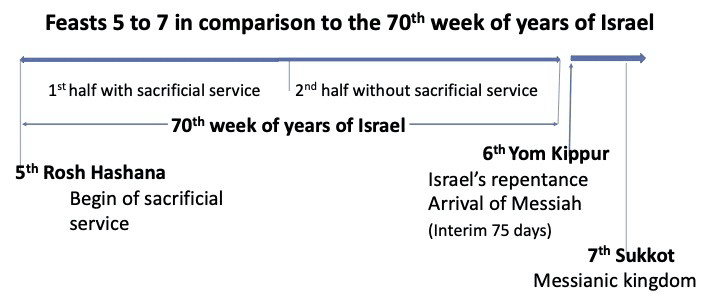
Figure 4. Time allocation of festivals 5 to 7 to the last week of years of Israel
In this kingdom of peace, Jerusalem is the peace capital of the whole earth, and the LORD is the King and Prince of Peace (see my article: “Ezekiel’s Vision of Israel’s Future”).
And the LORD shall be king over all the earth: in that day shall there be one LORD, and his name one (Zech.14,9).
Revelation mentions the duration of the kingdom of peace of 1000 years and the ruler of this kingdom, Christ, who, according to the quoted passage from Zechariah, is identical with the LORD:
And I saw thrones, and they sat upon them, and judgment was given unto them: and I saw the souls of them that were beheaded for the witness of Jesus, and for the word of God, and who had not worshiped the beast, neither his image, neither had received his mark upon their foreheads, or in their hands; and they lived and reigned with Christ a thousand years (Rev.20,4).
The prophetic word lights the way
In ancient times and the Middle Ages, the understanding of the prophetic word was largely obscured. The teaching that Israel was rejected by God and replaced by the church (replacement theology) covered Christianity in spiritual darkness. In this darkness the teaching was introduced that the Millennium began with the birth of Christ (Amillennialism).
Manuel de Lacunza's book, "The Coming of the Messiah in Power and Glory" was used by God to shed new light through the study of the prophetic writings. Of particular importance was the distinction emphasized by Lacunza between prophecy for Israel and prophecy for the Church.
In this new study of the prophecy God used especially J.N. Darby and his brothers. Recognizing that the false assumptions in the study of prophecy had rendered the theological work of centuries useless, they began an entirely new study of prophecy. In doing so, they rediscovered the hope of the rapture before the begin of God's wrath, which had been hidden for centuries under the rubble of false teachings.
Unfortunately, today such an unbiased study of prophecy has become very rare. Therefore, I would like to remind you once again of the basic principles for interpreting prophecy that I quoted at the beginning of this article. I ask the reader not only to compare my thoughts on prophecy with the usual interpretation, but also to consider whether they agree with the overall testimony of the Bible.
I would now like to share some personal experiences. In the 1970s, some Jewish couples visited us. Their big and most important questions were: How could God allow the Holocaust and why does He not judge these crimes?
In response, I read the verses from Revelation 6,9-11:
And when he had opened the fifth seal, I saw under the altar the souls of them that were slain for the word of God, and for the testimony which they held: And they cried with a loud voice, saying, How long, O Lord, holy and true, do you not judge and avenge our blood on them that dwell on the earth? And white robes were given unto every one of them; and it was said unto them, that they should rest yet for a little while, until their fellow servants also and their brethren, that should be killed as they were, should be fulfilled.
The claim of these martyrs is revenge. They had not yet washed their clothes in the blood of the Lamb before they died. From this I conclude that these are Old Testament believers who became martyrs. They ask why there was no judgment from God. Therefore, it is clear that at this time God's judgment on earth has not yet begun.
Therefore, the openings of seals 1-6 do not belong to this judgment. God's judgment on this earth begins with the 1st trumpet (Rev.8,7). For this reason, I think it is legitimate to ask whether the 5th seal was perhaps fulfilled in the Holocaust.
A few years later I had the opportunity to speak to David Gooding about the timeline of Revelation. His understanding was that the fife the openings in heaven mark a new section of Revelation.
He explained to me that the main problem with existing interpretations of Revelation is the lack of a reference point to Old Testament prophecy and suggested to take the arrival or return of the Messiah as a reference point. His suggestion was to establish a biblically based timeline using the time information in Revelation (cf. my article: “New Time Schedule of Revelation”).
During the Gulf Crisis, Sadam Hussein threatened to attack Israel with poison gas. The population in Israel therefore had to prepare appropriate protective measures. During this time, a friend told me that he had built a gas-protected bed for his baby daughter.
I was very moved by my friend’s fear. However, I knew that Prime Minister Yitzhak Shamir was determined to respond to such an attack with a nuclear retaliation. But to my understanding that would have triggered a global nuclear war. Rev.9 reports of an unimaginably terrible war with 200,000,000 soldiers in which 1/3 of humanity will die. It was clear to me that such destruction could only be possible through a global nuclear war and that the time for this war had not yet come. So, I wrote to my friend that I was convinced, based on Bible prophecy, that Israel would not now be attacked with poison gas. Later, this friend thanked me for my correct interpretation of Bible prophecy.
In recent times Putin's attempt to use the fear of a global nuclear war for psychological warfare is of no avail for me – and hopefully for many Christians also.
I have shared these experiences with you to show that knowledge of prophecy, including the prophecy of post-rapture events, is a light for us today (2Pet.1,19):
We have also a more sure word of prophecy; to which you do well that you take heed, as unto a light that shines in a dark place, until the day dawn, and the day star arise in your hearts.
(2024-01)